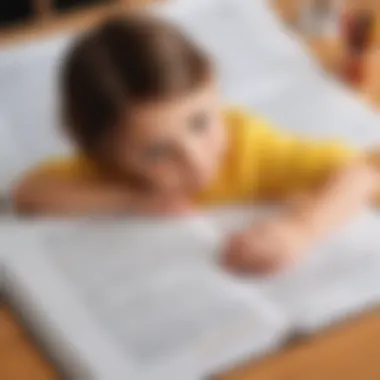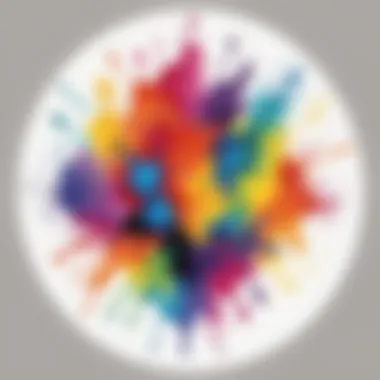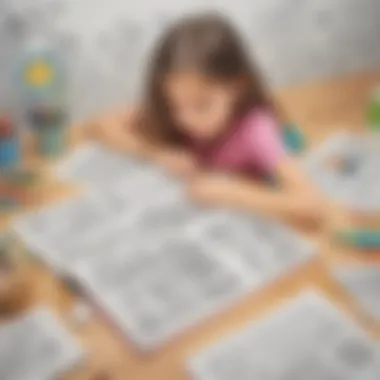Unlocking the Benefits of Free Handwriting Practice for Children


Fun Activities Ideas
Engaging children in various fun activities can significantly enhance their handwriting skills. Indoor activities like creating a mini letter writing station with colorful pens and personalized stationery can make writing a fun and appealing activity for kids. Outdoor adventures such as nature scavenger hunts where kids can write down their findings in a journal promote handwriting practice in an exciting way. Arts and crafts sessions involving activities like calligraphy with watercolors or creating alphabet collages not only boost fine motor skills but also foster a love for writing.
Educational Games
Incorporating educational games into kids' routines can make handwriting practice more interactive and stimulating. Math and logic games like Sudoku or Tangram puzzles provide a fun way for kids to work on their handwriting while exercising their cognitive abilities. Language and vocabulary games such as word search or scrabble help enhance writing skills alongside expanding their linguistic knowledge. STEM activities like creating written instructions for building simple machines encourage practical application of writing skills in a science-focused context.
Seasonal and Holiday Activities
Seasonal and holiday-themed activities present excellent opportunities to incorporate handwriting practice into festive occasions. Valentine's Day crafts like making handmade cards involve writing heartfelt messages, enhancing both creativity and handwriting skills. Halloween costume ideas where kids can write and design their spooky character descriptions promote imaginative writing alongside practical skills. Thanksgiving cooking projects with recipe writing tasks offer a hands-on approach to improving penmanship while engaging in holiday preparations.
Parenting Tips and Resources
Parents play a crucial role in nurturing children's handwriting abilities, and offering insightful tips can aid in this process. Encouraging creativity by providing writing prompts or story starters can inspire kids to write frequently and expressively. Creating a playful learning environment with designated writing corners equipped with various writing tools and paper choices can make practice sessions more enjoyable for kids. Balancing screen time with physical playtime encourages children to engage in handwriting activities actively, promoting holistic development.
Fun Facts and Trivia
Integrating fun facts and trivia into handwriting practice sessions can make learning a captivating experience for kids. Discovering intriguing insights about the animal kingdom while practicing writing animal names can make the activity both educational and entertaining. Delving into famous inventions stories through writing prompts can inspire kids to explore their innovative potential while honing their writing skills. Exploring historical events through written summaries enables children to connect with the past and refine their narrative abilities.
Introduction to Free Handwriting Practice


Understanding the Importance of Handwriting Skills ## Role of Handwriting in Cognitive Development Handwriting is a fundamental skill that plays a crucial role in a child's cognitive development. It engages multiple areas of the brain and enhances neural connectivity, aiding in the development of language, memory, and critical thinking. Through the physical act of writing, children establish a connection between the visual and motor areas of the brain, facilitating better retention and comprehension of information. Handwriting also promotes creativity and self-expression, allowing kids to communicate their thoughts and ideas in a unique and personalized manner. The tactile experience of writing by hand has been associated with improved information processing and knowledge retention in academic settings. Therefore, emphasizing handwriting practice at an early age can significantly benefit a child's cognitive growth and learning abilities. ### Fi tor Skills Development Fine motor skills refer to the coordination and control of small muscles in the hands and fingers, essential for tasks like writing, drawing, and manipulating objects. Engaging in handwriting activities helps children refine their fine motor skills, enhancing hand-eye coordination, dexterity, and precision. The intricate movements involved in forming letters and shapes by hand strengthen the muscles and improve control over writing tools, such as pencils and pens. This development not only fosters better handwriting legibility but also supports overall physical coordination and manual dexterity. Furthermore, fine motor skills are critical for day-to-day activities like buttoning shirts, tying shoelaces, and using utensils, highlighting the long-term importance of honing these skills through consistent handwriting practice.
Creativity and Expression
In the realm of childhood development, creativity and expression are essential facets that are nurtured through free handwriting practice. By providing children with the platform to express their thoughts, feelings, and imagination, handwriting practice becomes a gateway to unlocking their creative potential and enhancing emotional intelligence. This section will explore the profound impact of fostering creativity and expression through handwriting practice, highlighting its role in enriching children's cognitive and emotional well-being.
Stimulating Imagination
Stimulating Imagination
Stimulating imagination through handwriting practice is a transformative process that encourages children to explore the realms of creativity and innovation. By engaging in free-form writing, drawing, and storytelling, children unleash their imagination, envisioning worlds and narratives that transcend conventional boundaries. This imaginative stimulation fosters divergent thinking and problem-solving abilities, nurturing a mindset driven by curiosity and exploration. The unique feature of stimulating imagination lies in its capacity to ignite the creative spark within children, inspiring them to think beyond limits and embrace originality in their expression.
Emotional Outlet
Emotional Outlet
Emotional outlet is a vital aspect of handwriting practice that provides children with a means to channel their feelings and experiences through written expression. By allowing children to put their emotions into words, drawings, or symbols, handwriting practice becomes a cathartic outlet for processing and articulating complex emotions. This emotional release fosters self-awareness, empathy, and resilience, empowering children to navigate their inner world with clarity and understanding. The unique feature of emotional outlet lies in its therapeutic value, offering children a safe space to unveil their emotional landscape and cultivate mental well-being through creative expression.
Techniques for Effective Handwriting Practice
Engaging Activities for Kids
Drawing and Doodling


Exploring Drawing and Doodling as part of effective handwriting practice for children offers a creative outlet that enhances their motor skills and cognitive development. The key characteristic of Drawing and Doodling lies in its ability to allow for self-expression and creativity while honing hand-eye coordination. Children can benefit from the freedom these activities provide in exploring shapes, lines, and colors, promoting not only fine motor skills but also artistic appreciation. While the advantages of Drawing and Doodling are abundant in bolstering creativity and motor skills, it is essential to monitor excessive screen time or distraction from focused writing tasks.
Writing Prompts
Integrating Writing Prompts into handwriting practice stimulates children's imagination and critical thinking skills. By offering specific topics or scenarios to write about, Writing Prompts encourage creativity and structured writing exercises. The key characteristic of Writing Prompts lies in their ability to prompt spontaneous and thoughtful responses from young learners, further enhancing their writing fluency and linguistic development. While Writing Prompts are a popular choice for their ability to inspire storytelling and idea generation, it is crucial to tailor prompts to the child's age and interests to maintain engagement and relevance.
Utilizing Creative Resources
Interactive Writing Tools
Interactive Writing Tools play a crucial role in engaging children in the learning process by providing hands-on experiences that enhance writing skills. The key characteristic of Interactive Writing Tools is their ability to offer immediate feedback and customization options, tailoring practice sessions to individual needs. These tools not only make learning fun but also track progress, motivating children to set goals and improve their handwriting proficiency. While Interactive Writing Tools are highly beneficial in enhancing engagement and performance, it is essential to balance digital interactions with traditional writing practice to ensure a holistic development approach.
Themed Worksheets
Themed Worksheets provide a structured and thematic approach to handwriting practice, appealing to children's interests while reinforcing key writing concepts. The key characteristic of Themed Worksheets lies in their ability to incorporate diverse topics and exercises that align with educational goals and curriculum standards. By offering themed activities related to various subjects or seasons, these worksheets make handwriting practice more engaging and relevant to real-world contexts. While Themed Worksheets are a popular choice for their versatile and educational value, it is important to ensure that themes are age-appropriate and aligned with learning objectives to maximize their effectiveness.
Incorporating Fun and Learning
Games for Handwriting Improvement
Incorporating Games for Handwriting Improvement introduces an element of fun and competition into handwriting practice, making learning enjoyable and interactive for children. The key characteristic of Handwriting Games lies in their ability to blend skill-building with entertainment, encouraging repeated practice in a playful setting. These games not only enhance hand-eye coordination and fine motor skills but also promote a positive attitude towards writing. While Games for Handwriting Improvement are beneficial in enhancing engagement and motivation, it is essential to select games that align with learning objectives and provide constructive feedback to support skill development.


Penmanship Practice Challenges
Penmanship Practice Challenges present children with targeted tasks and goals to improve handwriting precision and fluency. The key characteristic of Practice Challenges lies in their ability to promote perseverance and skill refinement through focused writing exercises. By setting specific challenges such as speed writing or letter formation drills, children can enhance their penmanship skills while enjoying a structured and goal-oriented approach to practice. While Penmanship Practice Challenges are effective in developing writing proficiency and confidence, it is important to offer varied challenges to maintain interest and challenge different writing aspects for comprehensive skill development.
Tips for Parents and Educators
Encouraging Consistent Practice
Establishing Daily Routines
Delving deeper into the subheading of Establishing Daily Routines, this aspect focuses on the significance of incorporating consistent handwriting practice into a child's daily schedule. By establishing a structured routine for practicing handwriting, children can cultivate discipline and dedication towards enhancing their writing skills. Consistency in daily practice can lead to notable improvements in handwriting legibility, speed, and overall proficiency. The key characteristic of Establishing Daily Routines lies in its ability to create a habit-forming behavior that promotes continuous learning and growth. This approach is a popular choice for this article as it emphasizes the long-term benefits of regular practice in strengthening a child's handwriting abilities. The unique feature of Establishing Daily Routines is its capacity to internalize handwriting practice as a daily ritual, fostering a sense of responsibility and commitment in children. While setting daily routines can demand consistency and effort, the advantages of instilling this practice reflect in the steady progress and development of a child's handwriting skills.
Setting Achievable Goals
Moving on to Setting Achievable Goals, this aspect underscores the importance of defining clear and attainable objectives in the handwriting practice journey. By setting specific goals related to handwriting improvement, children can track their progress and stay motivated to enhance their skills. Setting Achievable Goals acts as a driving force that propels children towards continuous growth and development in their handwriting abilities. The key characteristic of this approach is its effectiveness in providing children with a sense of direction and purpose in their handwriting practice. Setting goals that are within reach ensures that children experience success at regular intervals, boosting their confidence and enthusiasm for further improvement. It is a beneficial choice for this article as it aligns with the theme of gradual progression and skill enhancement in handwriting practice. The unique feature of Setting Achievable Goals is its adaptive nature, allowing goals to be revised and tailored according to a child's pace and proficiency level. While there may be challenges in setting goals that are both challenging yet attainable, the advantages of this approach lie in fostering a growth mindset and instilling a sense of achievement in children.
Embracing the Journey of Handwriting Mastery
Within this context, 'Embracing the Journey of Handwriting Mastery' delves into the overarching theme of celebrating the evolutionary process of handwriting development in children. It emphasizes the significance of acknowledging and appreciating incremental advancements, instilling a sense of pride and accomplishment in young learners. By recognizing the efforts put into honing handwriting skills, children are encouraged to persist and excel in their writing abilities. The benefits of embracing the journey of handwriting mastery extend beyond mere technical proficiency. It fosters a growth mindset, preparing children to overcome challenges and setbacks with resilience and determination, traits essential for academic and personal success. By instilling a positive attitude towards learning and improvement, children develop a lifelong passion for self-improvement and mastery. The section further underscores the importance of setting realistic goals and milestones to gauge progress effectively. Celebrating the small victories along the way reinforces children's motivation and commitment to continual development, paving the way for excellence in handwriting skills. Embracing the journey of handwriting mastery is not just about achieving a final outcome but about embracing the iterative process of growth and learning.
Celebrating Progress and Achievements
Milestone Recognition
In the realm of free handwriting practice for kids, milestone recognition plays a vital role in reaffirming children's advancements and accomplishments on their handwriting journey. Recognizing and commemorating key milestones in handwriting proficiency serves as a tangible validation of children's hard work and dedication, boosting their confidence and self-esteem. The essence of milestone recognition lies in its ability to mark significant progress points, providing children with a sense of achievement and fulfillment. By acknowledging these milestones, parents, educators, and guardians can motivate children to strive for continuous improvement, instilling a sense of pride and satisfaction in their handwriting endeavors. The unique characteristic of milestone recognition lies in its personalized nature, tailoring celebrations to each child's progress and accomplishments. Whether it be mastering a challenging letter formation or improving writing legibility, milestone recognition acknowledges the individual efforts and achievements of each child, reinforcing their motivation and enthusiasm.
Showcasing Improvement
Showcasing improvement in handwriting is a fundamental aspect of nurturing children's development in this realm. By visibly highlighting progress and growth in handwriting skills, children are encouraged to aim for excellence and refinement in their writing abilities. Showcasing improvement serves as a visual representation of children's dedication and determination, inspiring them to push boundaries and reach new heights in their handwriting proficiency. The key characteristic of showcasing improvement lies in its transformative effect on children's mindset and attitude towards learning. When children observe tangible evidence of their progress, whether through enhanced penmanship or increased writing speed, they are motivated to set higher goals and strive for continued advancement. Showcasing improvement reinforces the connection between effort and success, fostering a sense of accomplishment and satisfaction in children. The unique feature of showcasing improvement is its ability to serve as a motivational tool, spurring children to challenge themselves and embrace growth opportunities. By showcasing incremental improvements in handwriting, children experience a sense of agency and control over their learning journey, empowering them to take ownership of their progress and achievements.



